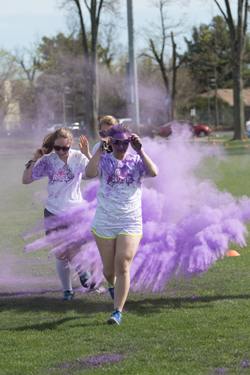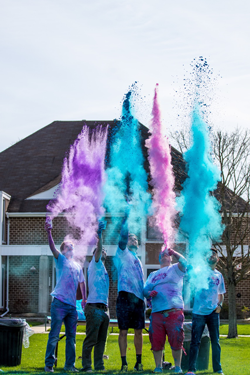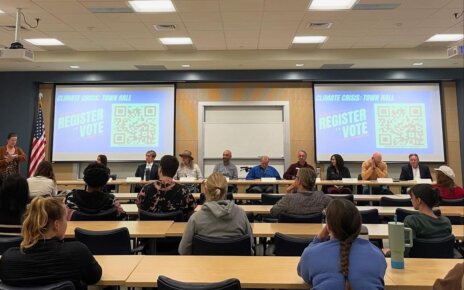Over 50 students participated in the University’s first ever ‘paint’ race, the Color Me Rose Run, to help raise over $1,100 for the Kortney Rose Foundation.
Students met in front of the Rebecca Stafford Student Center (RSSC) at 8:30 am. Personalized t-shirts and sunglasses were given to all registered runners. A DJ played music on the patio. At 9:35 am, more than 50 students geared in white t-shirts gathered on the pavement.
Mitchell Parker, a junior biology major and the official coordinator of the run, met the crowd with a short speech. “A lot of time and work has gone into preparing for this day. I appreciate you all for being here to support the Kortney Rose Foundation,” said Parker.
Following the speech, Parker announced that the start of the run would begin with a unified countdown. In synchronization, the students counted from ten to zero, and the run began.
Guides lined the trail in the form of people, balloons, and cones. The runners traveled around Woodrow Wilson Hall and cut across Great Lawn. Throughout the run students were met with stationed volunteers who pelted the runners with dyed powder. The powder was dyed corn starch.
“I was a little scared about being attacked with colored powder, but it was really fun! I loved the overall welcoming atmosphere of the event and it was a really great experience,” said Patricia Toomey, a freshman criminal justice student.
Following Great Lawn, the runners trecked past Pollak Theatre and were directed towards the finish line in a gravel lot beside the University’s greenhouse. Students conjugated in excitement for the ‘color run’ afterparty. Volunteers passed out small ziplock bags of dyed powder, and on Parker’s request, the powder was thrown into the air above the runners in a large cloud of color.
The Color Me Rose Run was less than a mile long. Although it was a relatively short run, Parker said it had a large significane on the University community. He explained that the run supported the Kortney Rose Foundation, a non-profit organization that raises money for the comprehensive research of pediatric brain tumors.
Established in 2007 by Kristen Gillette, Secretary of the Political Science and Sociology Department, this foundation is supported in honor of the late Kortney Rose Gillette, Kristen’s daughter. Kortney Rose passed away from a pediatric brain tumor at the age of 9. After being diagnosed in 2006, Kortney lost her battle at the Childrens Hospital of Philadelphia (CHOP) four months later.
 Parker explained that he met Gillette during his freshman year though the Honors School when he was creating Halloween decorations for a wing in CHOP. He said, “I was really moved, when I heard the story of how the Kortney Rose Foundation was founded in memory of Kortney Rose Gillette. When it came time to plan the run, I knew order to support the Kortney Rose Foundation. Rose continued from p. 1 that I wanted to use the event to raise money for a meaningful, campus-related organization, and the Kortney Rose Foundation was the first that came to mind.”
Parker explained that he met Gillette during his freshman year though the Honors School when he was creating Halloween decorations for a wing in CHOP. He said, “I was really moved, when I heard the story of how the Kortney Rose Foundation was founded in memory of Kortney Rose Gillette. When it came time to plan the run, I knew order to support the Kortney Rose Foundation. Rose continued from p. 1 that I wanted to use the event to raise money for a meaningful, campus-related organization, and the Kortney Rose Foundation was the first that came to mind.”
“We are always grateful when students take an interest in raising funds for our cause. We appreciate any opportunity to raise awareness and research funding. We also like that our work inspires young people to make a difference,” said Gillette.
“It was very exciting and humbling to have hosted the University’s first ‘color run.’ I didn’t know if I could do it, but I had a lot of support from family, friends, and people from many different organizations. I just wanted to give back to the campus community and have something that everyone could relate to in honor of Kortney Rose Gillette,” said Parker.
The Kortney Rose Foundation is a way of immortalizing the memory of Kortney Rose Gillette through the betterment of child life. Proceeds accumulated by the organization support research at CHOP. In 2013, the Huffington Post ranked CHOP the number one children’s hospital in the nation.
This year alone, the Kortney Rose Foundation has raised over 1 million dollars in donations from fundraisers such as the Color Me Rose Run. “All of my work is to create Kortney’s legacy of helping other children with brain tumors through the promise of research,” said Gillette.
Four percent of federal funding goes to pediatric cancer research, stated Gillette. “The other 96 percent is allotted to adult cancer research,” she continued.
According to thekortneyrosefoundation.org, there is an estimated 3,500 children who are diagnosed with brain tumors every year, and such children are expected to live no longer than five years following their diagnosis.
Toomey said, “Running for research for pediatric brain tumors made what I was doing feel significant. It just added more to the fun experience. It’s amazing to think that we were able to help other people who really needed it, while also enjoying a nice early morning run.”
It took two years for Parker to transform the idea of hosting a ‘color run’ into a reality. “It was very hard to get it planned because they (the University) had never done it on campus before. This run was really a test run to see if we could have other ‘color runs’ in the future.”
Parker explained that the planning for the Color Me Rose Run required hours of meeting with campus officials to get various aspects of the event approved. A skillful plan had to be made that included a budget, run route, and a plan of action for doing signups, ordering supplies, and executing the event.
 “It was hard to determine the proper protocol for the event in terms of how many volunteers were needed, what supplies needed to be order, and what things had to be done to ensure no damage happened to the University from the powdered paint,” added Parker.
“It was hard to determine the proper protocol for the event in terms of how many volunteers were needed, what supplies needed to be order, and what things had to be done to ensure no damage happened to the University from the powdered paint,” added Parker.
“We were only allowed to throw the powdered paint on the Great Lawn and gravel lot behind facilities management,” continued Parker. “When wet, powdered paint can make hardtop surfaces very slippery, therefore, we could not throw it in the streets.”
The biggest struggle, according to Parker, in hosting this event was advertising. “Fliers were put all over campus and posted on social media, however, people just didn’t realize for some reason that we were tabling on the 2nd floor of the Students Center,” added Parker. Additionally, he could only advertise to students and keep this a Monmouth-centered event, which was another setback in advertising techniques.
Initially, Parker wanted 170 people to attend the event, but only 40 people pre-registered. Due to the ‘low’ numbers, Student Activities then capped the event to 80 people.
“When I decided I wanted to do a ‘color run,’ I was the president of a brand new running club. Since we were new we didn’t have funding. I applied for funding this semester because it costs a lot for paint and everything. Once I got funding from SGA I was able to get approval from Student Activities,” said Parker.
“I helped Mitchell with the underlying details. He had to get permission to use certain fields, figure out where they would run. I also helped him with ordering and everything. I helped him figure out the pieces that he needed to actually run the race. It took a long time to put it all together, but I think it was successful,” said Amy Bellina, Director of Student Activities and Student Center Operations.
Parker is planning on executing another Color Me Rose Run in the upcoming fall semester. For this run, he plans on making the run route a tad longer by having overlapping routes. “I made the decision not to do this initially because it was the first paint run at Monmouth and I did not want to complicate it any further,” he explained.
“I loved the fact that everyone came out so early on a Sunday morning to support such a wonderful cause. It was so nice to see all the smiling, excited faces at race start,” said Parker. “It is very humbling.”
Additional reporting conducted by Brianna McCabe.
PHOTOS COURTESY of Max Goldberg



